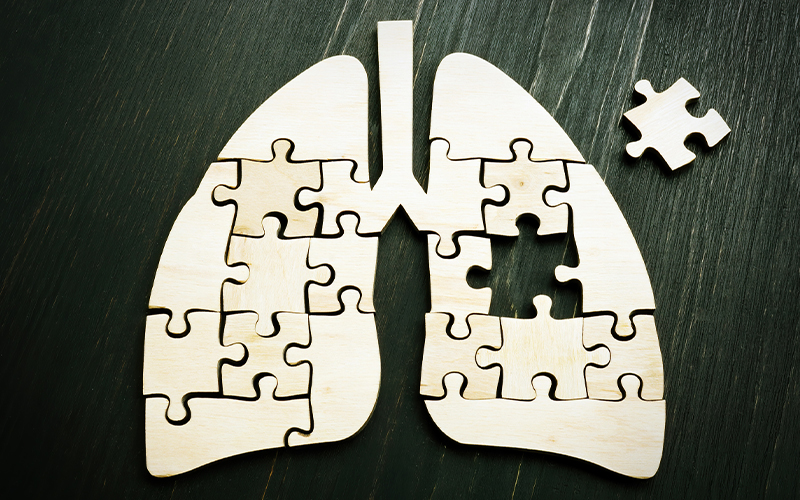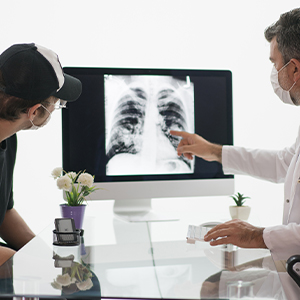Lung Cancer: Risk, Screening, and Prevention

November is Lung Cancer Awareness Month. Every year we take this time to reflect on the sobering statistics related to lung cancer in the United States.
Among them, lung cancer is the second most common cancer diagnosed among both men and women. It’s also the leading cancer cause of death.
But it doesn’t have to be.
If you’re a lifelong smoker, or have a family history of the disease, consider talking to your primary care provider or family doctor about a screening. Quitting smoking is the number one thing you can do to reduce your risk.
“Screening and detection are proven low-cost tools that can mean the difference between curable and advanced-stage lung cancer,” said Yelena Kier, DO, Oncologist at Cowell Family Cancer Center in Traverse City.
If you’re not sure what causes lung cancer, or how to know if you’re at risk, read on for some insight.
What is lung cancer, exactly?

describes those cancers that begin in the cells of the lungs. Cancer starts when cells change and grow out of control. These mutated cells often grow to form lumps or tumors that can spread to other areas of the body
Lung cancer is divided into three main types:
- Non-small cell lung cancer. Most lung cancers are non-small cell. They're named for how cancer cells look under a microscope. There are a few different types, such as squamous cell carcinoma, adenocarcinoma, and large cell carcinoma.
- Small cell lung cancer. Small cell lung cancer is less common than non-small cell lung cancer. Small cell cancer is sometimes called oat cell cancer because the cancer cells are shaped like oats when looked at under a microscope. This type of lung cancer may grow and spread faster than non-small cell cancer.
- Lung carcinoid tumors. Less than five percent of lung cancers are lung carcinoid (sometimes called lung neuroendocrine) tumors. Most of these tumors grow slowly and rarely spread.
What are the symptoms of lung cancer?

Lung cancer often doesn’t cause symptoms in its early stages. In fact, many lung cancers don’t cause symptoms until they have already spread.
When early-stage lung cancer does cause symptoms, they’re often like those you might have if you smoke. Common symptoms include:
- Cough that doesn’t go away or gets worse over time
- Chest pain, which might be worse when coughing or taking a deep breath
- Coughing up blood or rust-colored mucus
- Shortness of breath
- Hoarseness
- Wheezing
- Appetite loss
- Unexpected weight loss
- Feeling tired or weak
- Pneumonia or bronchitis occurring more than usual for you
- Swelling in the face or neck
It’s important to see your primary care provider if you have these symptoms. Many may be caused by other health problems, but only a healthcare provider can tell if you have lung cancer.
Are there risk factors for lung cancer?
Long-term cigarette smoking is the biggest risk factor for lung cancer by far, but it’s not the only one. Other common risk factors include:
- Exposure to secondhand smoke or radon
- Exposure to asbestos and other chemicals, such as arsenic and coal products
- Air pollution
- Radiation therapy to the chest
- Personal or family history of lung cancer
- HIV infection
If you have these symptoms and meet the criteria above, ask your primary care provider if you qualify for a screening. You should also check with your health insurance company to determine your coverage before scheduling.
Are there screening tests for lung cancer?

Thankfully, yes. The screening test used for lung cancer is called a low-dose or spiral CT scan. This screening may help find some types of lung cancer early when it’s often easier to treat.
The United States Preventative Services Task Force recommends a yearly lung cancer screening with low-dose computed tomography (LDCT) for people who have a history of heavy smoking and who smoke now or have quit within the past 15 years. Only your medical provider can order this screening.
Eligible individuals must be at least 50 years old and have smoked for at least 20 pack years. The term "pack-year" describes how many cigarettes you have smoked in your lifetime. One pack is equal to 20 cigarettes, so one pack a day for the last 20 years (or two packs a day for the last 10 years) equals 20 pack-years.
Medicare Eligibility Includes:
- Age: 55-77
- Pack years: At least 30 (current smokers or those who quit in the last 15 years)
Commercial Insurance Payer Eligibility Includes:
- Age: 50-80
- Pack years: At least 20 (current smokers or those who quit in the last 15 years)
Can lung cancer be prevented?

There is no sure way to prevent all lung cancers. But you may be able to help lower your risk by following these healthy habits:
- Not smoking, or quitting if you do smoke
- Staying away from other people's smoke
- Having your home tested for radon
- Limiting your exposure to chemicals that can cause lung cancer, such as diesel exhaust and asbestos
- Eating a healthy diet with lots of fruits and vegetables
“Munson Healthcare’s lung cancer screening program for eligible patients with a history of smoking has discovered more than one hundred new cases of limited lung cancer in the past few years and appropriate treatment has been instituted through our providers,” said David Gordon, MD, Oncologist at Cowell Family Cancer Center in Traverse City. “Contact your primary care provider regarding screening and prevention and stop smoking. Even if you have smoked for some time, cessation can improve your chances of avoiding these diseases.”
Talk with your healthcare provider about your risk factors for lung cancer and what you can do about them. If you smoke, take steps toward quitting as soon as you’re able. Munson Healthcare offers three Freedom from Smoking 8-Week Virtual Programs each year to help you kick the habit.
If you feel you should be screened for lung cancer, make sure to talk to your primary care provider. If you don’t have a medical provider or family doctor, call Munson Healthcare Ask-A-Nurse at 231-935-0951. Our team of registered nurses will help you find a provider in your area.